Saltwater shore fishing is one of the most accessible types of fishing. No boat and kayak are needed, keeping your costs and time commitment low (if you choose). Wading is optional but is typically not required in most cases. There is tremendous opportunity to catch big and small fish from shore, and there is also tremendous opportunity to get skunked! Therefore, building knowledge and experience are essential, and so is paying attention to details. This article will cover the basics of this style of fishing and will provide links for further reading.
Shore Fishing Overview
Basic shore fishing appears quite simple to the casual observer. You simply stand on a “shore” or “shoreline” and cast into the water. Just stand…and cast. However, there is much more than meets the eye, and successful shore fishing involves a combination of knowledge, skill, and dedication.
One thing that all shore-based fishing has in common is the that the fisherman has hard limits on his “range of movement”. First, he is limited in how far he can cast from shore; if gamefish are see attacking baitfish beyond his casting range, there is nothing he can do about it. Second, he is limited in how far down the shore (or pier, or jetty) he can walk. Third, he has no say on how crowded/not crowded a particular location is. Large crowds can limit his mobility, and in some cases cause frustration (people encroaching too close, line tangles, etc.).
There are more types/styles of gear to consider for shore-based fishing than there is for the other types of fishing. Largely, it depends on what type/size fish you are trying to catch, and what category of shoreline you are fishing. Are you planning to fish for big sharks from the beach? There is special gear for that (actually, there is a whole niche of saltwater gear and knowledge that is focused on catching big sharks from the surf). What about sheepshead from a jetty? There are certain tackle and bait considerations for that situation. Or maybe you want to catch smaller fish from a marina bulkhead? Consider smaller hooks and a light tackle setup.
I discuss gear selection shoreline categories and gear selection in the sections below.
Basic Shoreline Categories
There are various categories of shore fishing. These include:
- Jetties
- Breakwaters
- The surf
- Bulkheads and seawalls
- Channels
- Rip rap shorelines
- Natural shorelines
- Piers bridges
It probably goes without saying that a shoreline can include just one of the categories above, or it can be two or more categories at the same time. For example, a pier situated over or adjacent to a channel is really two categories (pier fishing + channel fishing). Below, I discuss examples of each of these categories.
Jetties
A jetty is a large rock structure (usually granite) built by the government to protect a navigable, deepwater shipping channel from waves and excess siltation. Texas has several famous jetties. Here is an aerial image of the Port Aransas Jetties located near Corpus Christi.
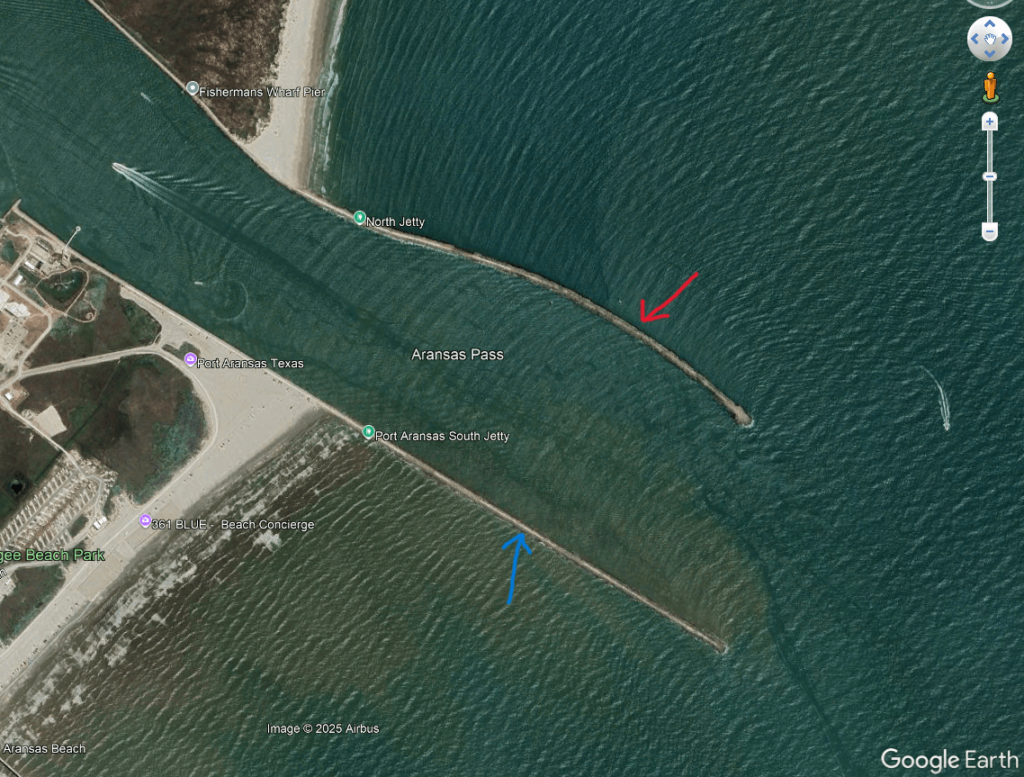
These jetties are used to protect the entrance to the Corpus Christi Ship Channel. The North Jetty is marked by the red arrow and the South Jetty is marked by the blue arrow.
Breakwaters
Somewhat similar to jetties are “breakwaters”, also sometimes called “dikes”. Wheras a jetty is intended to protect a channel entrance, breakwaters are intended to protect a marina or a harbor. Breakwaters can be constructed of large rocks, like jetties, or can be constructed of concrete (i.e., in which case, they are also a bulkhead; see below).
Here is the rock breakwater protecting the Corpus Christi marina (shown by the red arrow):
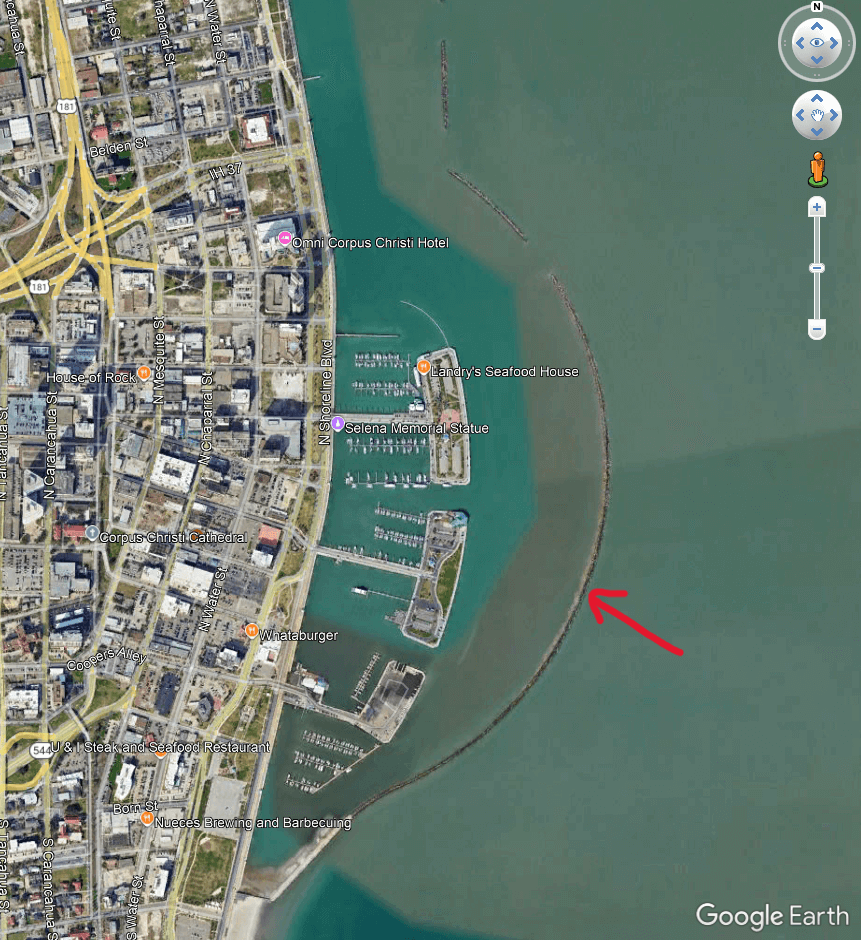
Here is a smaller concrete breakwater/bulkhead protecting a small harbor in downtown Corpus Christi (shown by the red arrow):
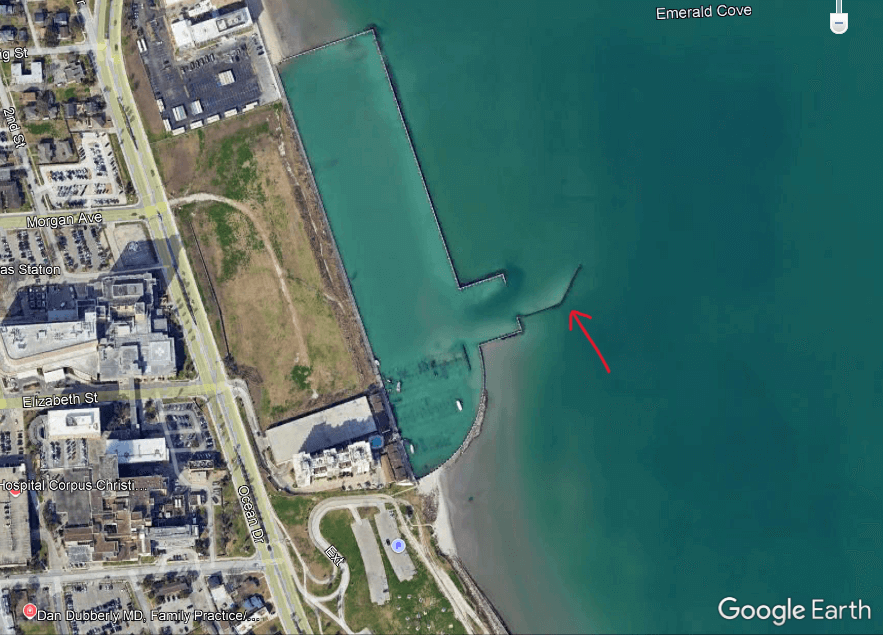
Here is a famous breakwater known as the “Texas City Dike” in Galveston Bay, a well-known fish holding structure (shown by red arrow):

Also somewhat similar to jetties and breakwaters are “groins”. These are structures designed to protect a beach from erosion by trapping sand. Groins, like jetties, are constructed of large granite rocks. The most well-known groins in Texas are located in Galveston, although there may be other locations. Here are a couple of the groins along the Galveston beachfront (shown by the red arrows):
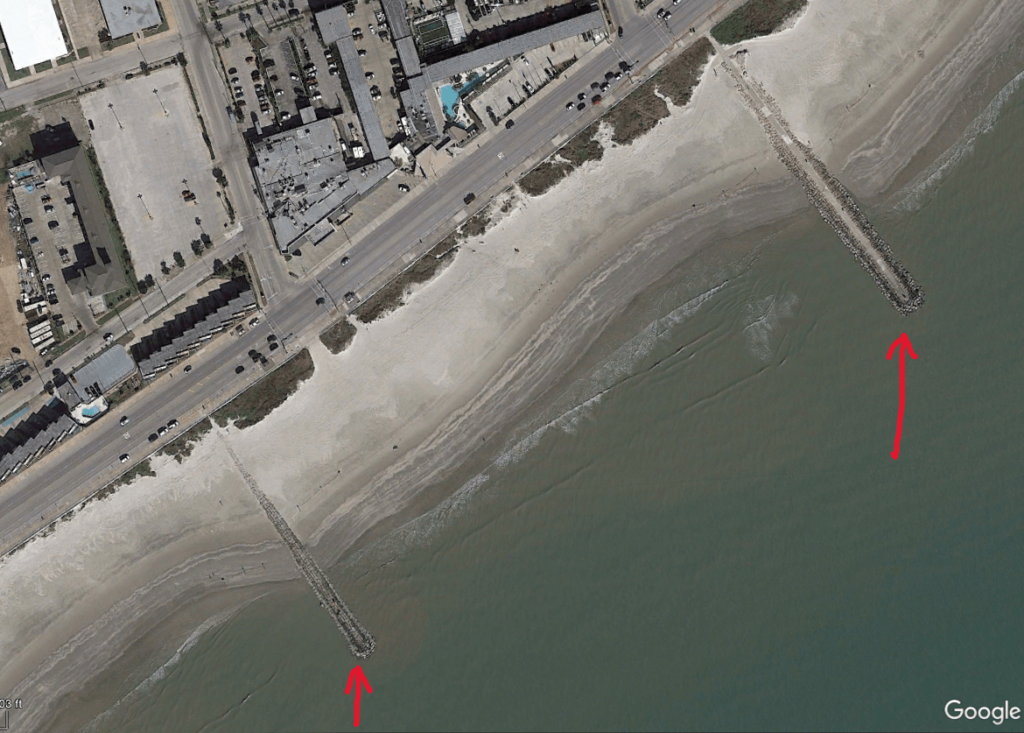
The Surf
The Texas coast is guarded by long, thin islands called “barrier islands”. The ocean side of these barrier islands is the “beach”, and the shallow water just off of the beach is the “surf” or “surf zone”. Beyond the surf zone are “nearshore waters”. Here is a picture of the Padre Island National Seashore, showing the beach (blue arrow), surf zone (red area), and nearshore waters (orange area):

Fishing in the surf zone is called surf fishing. Typically, the surf zone has a sandy bottom, with no mud, rocks, grass, or any other type of bottom structure. The sandy bottom, due to the incoming wave action, forms large mounds of sand that run parallel to the beach. The mounds are called “sand bars” or just “bars”. Between these bars are troughs called “guts”. Gamefish use these bars and guts to travel along the beach and ambush food. These bars and guts are constantly moving and adjusting; they are never static. The best surf fishermen learn how to read these structures in real time, because the location you find fish one day is not necessarily the location you find fish the next day. Generally speaking, Texas beaches have three guts. At any given time, fish can be found in any of these, or none of these.
Bulkheads and Seawalls
Shorelines of some inshore areas are protected by bulkheads or seawalls. Seawalls are generally intended to protect parts of a town from hurricane force waves and surge, and bulkheads are intended to provide a hard edge to water front properties to prevent erosion. Bulkheads and seawalls are generally constructed of concrete, and usually consist of a vertical concrete face at the water’s edge.
Channels
Channel fishing is simply fishing along the edge of a channel, with the hopes of catching fish that are passing through. Fish use channels like highways to get from Point A to Point B, and fishing along a channel can be a great way to intercept them. Here is an aerial picture of Packery Channel in Corpus Christi (channel shown by the red arrow):
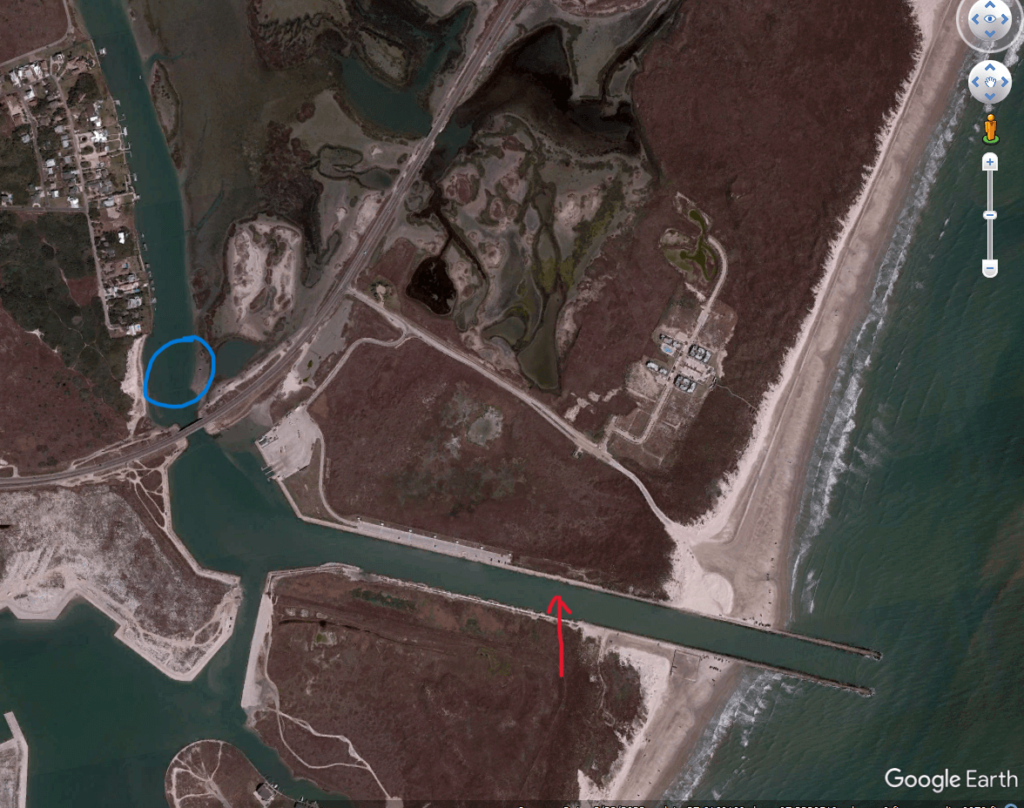
On any given day, you can see fishermen congregated along the edges of this channel. One particularly popular spot is the area circled in blue.
Rip Rap Shorelines
Rip rap is basically rock or crushed concrete that is used to stabilize a shoreline and prevent erosion. Rip rap can be used in conjunction with other shoreline features, like bulkheads and seawalls, or it can be a standalone feature. Large sections of the main Corpus Christi Bay shoreline are rip rap (shown by red arrow):
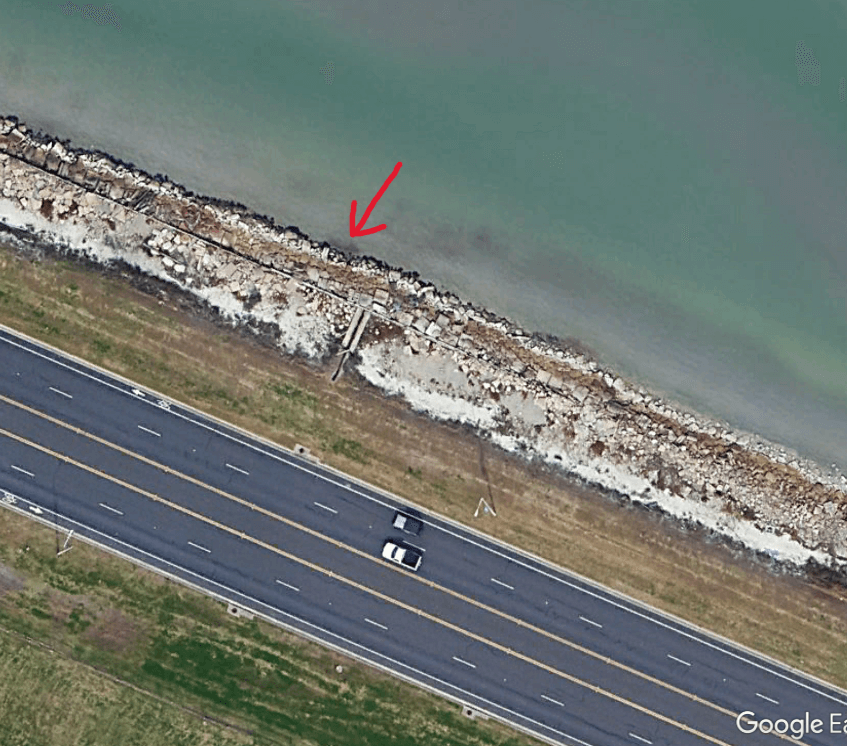
Natural Shorelines
Natural shorelines are common in calmer areas of the bay or laguna, where tidal movements occur, but where violent waves are not typically present, and erosion is less severe. The backside of Mustang Island is an example of a natural shoreline (area circled in red):
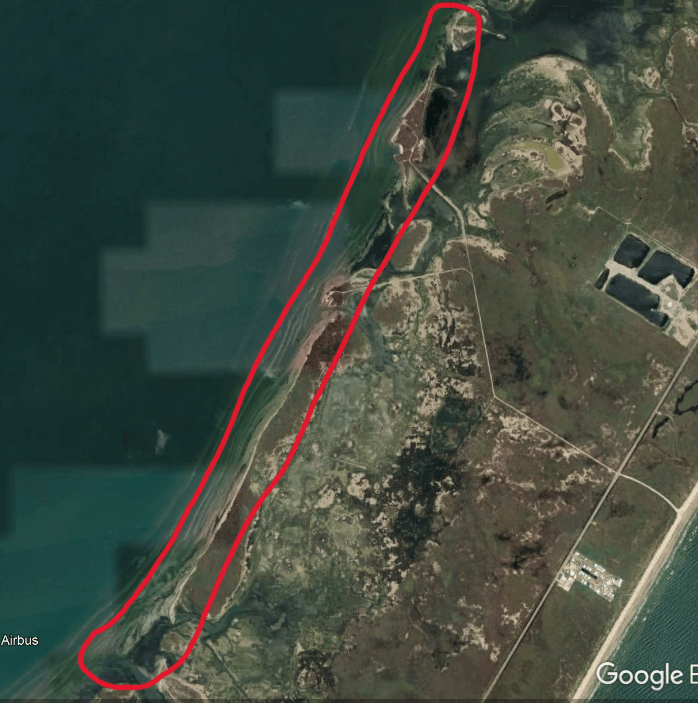
Piers and Bridges
Pier fishing is really a sub-type of the other types of fishing discussed above. Some piers are situated over the surf, others are situated along channels, and some allow you to fish the deeper waters along a shoreline. Piers allow you to access areas that would be difficult to access without a boat or kayak. Their pilings create hard structure in areas where there typically isn’t much, and this can be attractive to fish at certain times. There are several piers in the Corpus Christi, Texas area that have been around for a long, long time and many fish have been caught over the years.
Here is Indian Point Pier, situated over Corpus Christi Bay:
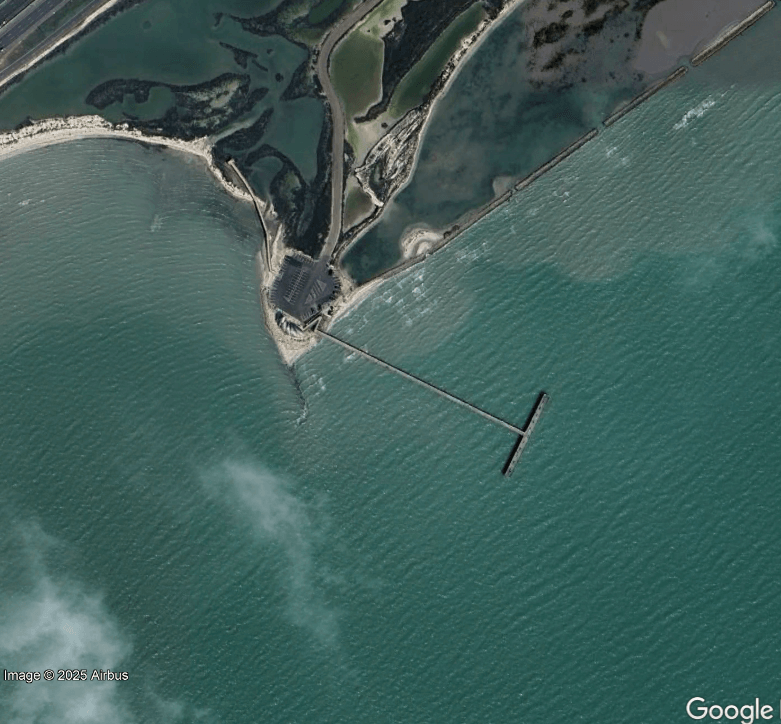
This pier allows you to fish the deeper waters of the northern bay shoreline near Portland, TX.
Here are a couple of Piers along the Humble Channel in the Laguna Madre:
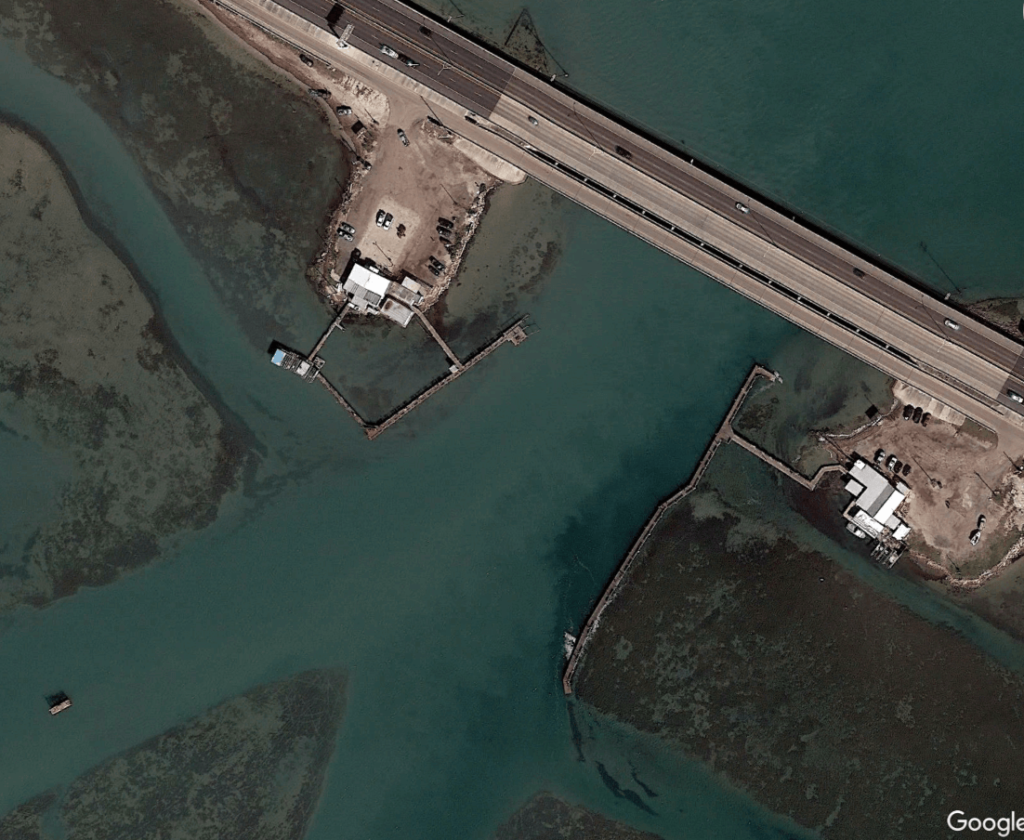
The “Cos Way” pier is the one on the left, and the “Red Dot” pier is the one on the right. These piers allow you to fish each side of the channel. This are popular spots to catch oversized black drum in the winter months, and speckled trout under the lights in the summer.
Here is the Horace Caldwell Pier in Port Aransas, situated over the surf zone in the Gulf of Mexico:
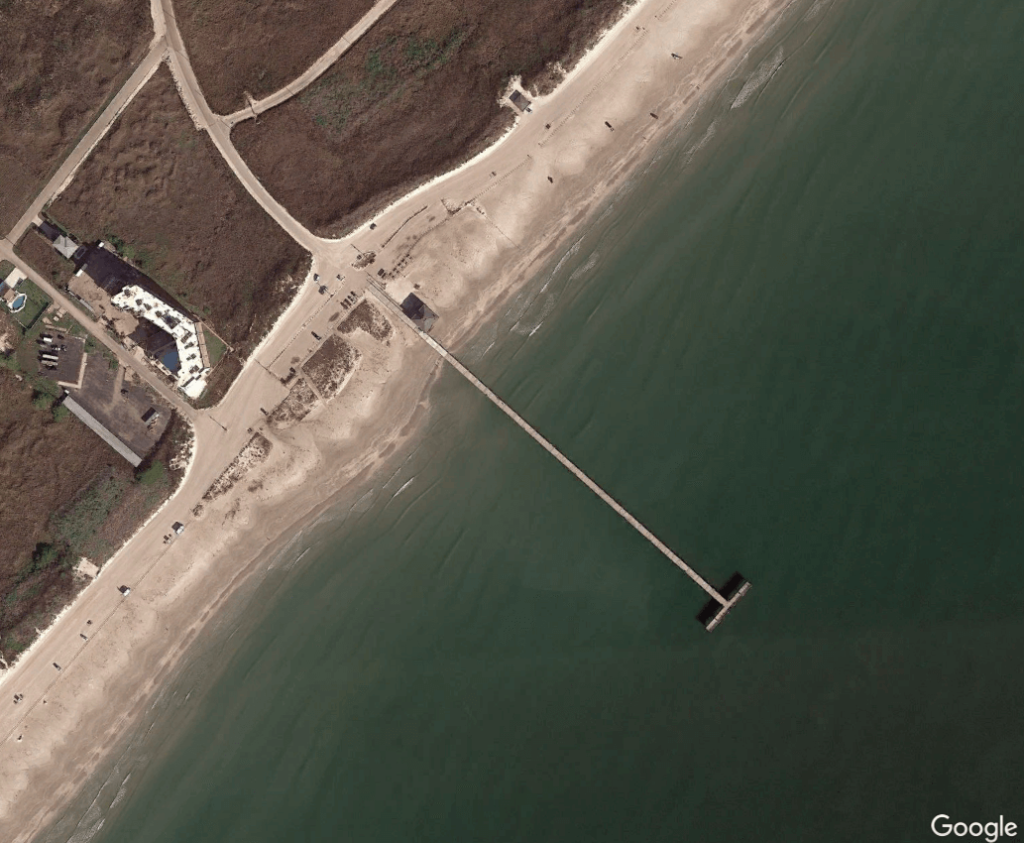
Several miles south of this location was Bob Hall Pier, also situated over the Gulf. It was destroyed by a hurricane but hopefully it will stand again some day.
Long Waits, Tough Weather, and Late Nights
One hard truth about shore fishing, is that it can be a waiting game. As mentioned at the beginning of this article, you are quite limited in your range of movement. However, keeper fish and bigger fish are caught by shore fishermen all the time. As with all fishing, it’s a matter of timing, skill, patience, and a million other factors. The more you go, the better you will get and the better your timing will be.
If you don’t enjoy the waiting game, there is one way to get some excitement that sometimes works, and that is to fish for “what’s there”. You may have had high hopes of catching redfish in the surf on Sunday, but unfortunately, the redfish didn’t know about your Sunday plans and you have had no such luck. How about switching to a smaller bait rig and try to catch some whiting? Those are lots of fun and it’s better than being bored and skunked.
Generally though, shore fishermen are known to be a tough breed. Many of them more than willing to wait it out, despite cold or windy conditions. It is also common for shore fishermen to fish throughout the night and early morning hours. They know that big fish (like oversized black drum) are sometimes caught in nasty conditions, and they are more than willing to put in the hours (day or night) to get them.
How to Get Started
My belief is that shore-based fishing is the easiest way to start fishing if you’ve never fished before, because you can start this way with the least amount of gear, and you don’t have to worry about getting too wet. As always, my best recommendation is to keep it simple! I would recommend starting out with typical “bay setup”, i.e., using rods, reels, and tackle that you would use in any other type of inshore or bay fishing scenario (which includes kayak fishing and wadefishing. See my recommendations for selecting bay rods, here, and some options for reliable fishing reels, here.
I also recommend that you keep your initial rigging as simple as possible. A basic fish-finder rig or single drop bottom rig is a great way to start. Although hook size is not too critical, I recommend the “small hook” approach when starting out….you won’t catch large fish, but you will hook more fish (and a wider variety of fish) this way.
A handy way to carry tackle for basic shore fishing is using a simple backpack (see here).
As far as difficulty, I rank the various shore fishing categories as follows:
Easy…
Pier fishing, bulkhead fishing, channel fishing fall in the easy category. This is easy fishing because you will generally not have to contend with overwhelming conditions or need specialized gear. Note that with pier fishing, sometimes it is useful to have pier net to land big fish. Just because it is easy, doesn’t mean that there aren’t frustrations. As mentioned at the beginning, you are quite limited with your options. Either the fish are there, or they aren’t. Maybe they are feeding, maybe they aren’t. Timing is everything, and you may have to make several trips to a pier until you catch a quality fish. Also, fishing a pier at a popular time (like during oversized drum season) you will be elbow to elbow with other fishermen and will have to contend with frequent line tangles.
A bit harder…
Surf fishing for close-in species, like whiting, falls into this category. Not too difficult really, but on the beach you must be careful not to get sand or saltwater into you reels. Plus, it is oftentimes helpful to wade into the surf when you fish, increasing the likelihood of dunking a reel in incoming waves. Also, in the surf you may have to contend with longshore current or sargassum (“seaweed”), which can be frustrating, and also have to be careful that you don’t accidentally hook a nearby swimmer.
Harder yet…
Jetty fishing. It is harder because you will lose lots of tackle. If you are going to fish the jetties, rocks are everywhere, so you must accept tackle loss as a fact. Also, good jetty fishermen learn how to “read the rocks”, which is a skill that most fishermen haven’t developed. With that being said, don’t be afraid of jetty fishing. It can be absolutely fantastic and the pain can be worth it. One option to limit tackle loss is to use a float or lemon rig setup, which can be very effective at certain times and for certain species. Another option, is to fish more on the surf side of the jetty than you do on the channel side of the jetty. By fishing on the surf side, the bottom is mostly sand and you will only have to contend with rocks when reeling in.
Hardest…
Specialty surf fishing (i.e., large sharks, large seatrout, kingfish, tarpon, etc). For any of these situations, specialty gear or knowledge is required. Catching large sharks requires kayaks (to carry large baits out into the water), large reels (expensive), and 4×4 vehicles, typically. Catching large trout in the surf requires an almost expert level of knowledge and ability to read the water, that few fishermen have developed. Tarpon and kingfish can also be caught from the surf, but your timing must be on-point and special rigging is needed.
Have a reel good day,
– The Simple Fisherman
